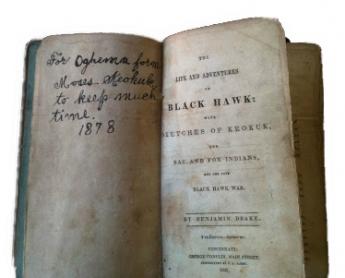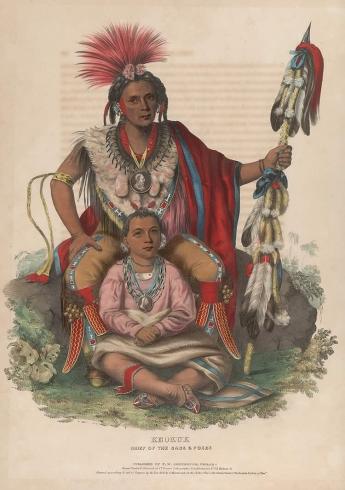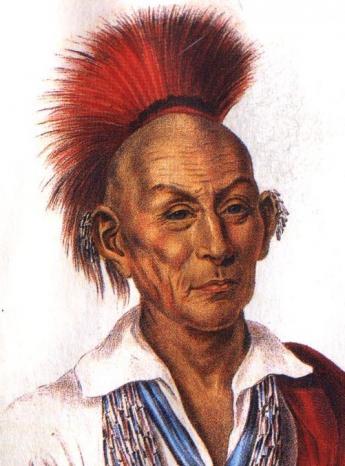Tip Antiquarian Booksellers' Association of America Lighthouse Books, ABAA
Collecting Rare Books and First Editions - Black Hawk, Keokuk and the Legends

By Michael Slicker
In 1878, when Chief Thunderwater was 13 years old and not yet a chief, his uncle gave him an extraordinary book, titled The Life and Adventures of Black Hawk: With Sketches of Keokuk, the Sac and Fox Indians, and the Late Black Hawk War.
Chief Thunderwater’s uncle was a very important man, a chief of the Sac (Sauk) and Fox tribe, named Moses Keokuk. Moses’ father (Chief Thunderwater’s grandfather) was an important man, too, and he had a large section in the book. Moses inscribed the book to Chief Thunderwater, who was also known as Oghema Niagara. “For Oghema,” he wrote, “form (sic) Moses Keokuk to keep much time,” and dated it 1878. The book is in the collection of rare and unusual books at Lighthouse Books, ABAA. When he received the book, Oghema was traveling and performing, along with his family, in Buffalo Bill’s Wild West Show.
It was far different than the life his grandfather – or even his parents – had led. Indeed, Oghema’s father, Jee-Wan-Ga, was a hunter and healer. He earned a living selling furs and herbal remedies to the white men. Oghema’s mother, Aw-Pau-Che-Kaw-Paw -Qua, was one of Keokuk’s many daughters. Keokuk had eight wives.
The tribe had lived mostly in an area west of Lake Michigan that became Illinois, Wisconsin, Iowa, Nebraska and Missouri. The tribe fought on the side of the British in the War of 1812, and many held little regard for the Americans. Black Hawk wasn’t a chief but he had achieved a position of leadership through his deeds of courage.
Black Hawk had a rival who also came up the hard way: Keokuk, who was an ambitious man. He became the tribal guest-keeper and he saw the opportunity to use his position in the tribe to gain more power and prestige. In 1830, while Black Hawk and his warriors were away on a hunting trip, Keokuk and others entered into a treaty with American officials that ceded Indian lands to the United States in exchange for cash and other considerations. Keokuk became a principal negotiator in that agreement. Included in the land deal was the ancestral home and birthplace of Black Hawk near what is now Rock Island, Illinois.
When Black Hawk returned, he was livid. He contended that Keokuk had no authority to make such a treaty. Inevitably, there ensued an armed conflict that became known as the Black Hawk War. It lasted for five months in 1832. Several future luminaries participated in the war, including Abraham Lincoln (in his only military service), Jefferson Davis, Winfield Scott and Zachary Taylor.
The final battle, called the Battle of Bad Axe, turned into a massacre, with women and children slaughtered by American soldiers as they tried to flee across the Mississippi River. Black Hawk initially escaped, but was later captured under a flag of truce and imprisoned for a year. Eventually, Keokuk became the designated chief of the tribe. The war over, the United States government set about in earnest to move Native Americans west of the Mississippi River to Indian Territory.
About six years later, Benjamin Drake, a newspaper editor and historian from Cincinnati, published this book about Black Hawk, Keokuk, the Sac and Fox tribe and the Black Hawk War. The book apparently did very well, selling many copies and going into several printings.
Moses Keokuk, son of Keokuk, became leader of the Sac and Fox tribe upon his father’s death in 1848. Like his father, Moses was a pragmatic sort who negotiated the best possible situation for his people under the circumstances. He was actually quite inclined toward an Euroamerican lifestyle. He lived in a house in the Indian Territory and he became a Baptist minister in 1877. He encouraged his people to become Christians. His exhortations apparently didn’t influence his nephew, however.
Oghema Niagara grew up to become Chief Thunderwater, who lived in Cleveland for many years and became active in Indian political affairs both in the United States and Canada, where he rankled federal officials by pushing for better health care and education for Native Americans. He encouraged Native Americans to adhere to the old beliefs, eschewing Christianity. He supported himself for a time creating and selling herbal remedies learned from his father under labels like Thunderwater’s Mohawk Oil and Jee-Wan-Ga Tea.
Chief Thunderwater became known as an outspoken advocate of Indian rights. He successfully stopped an attempt by developers to move the Erie Street Cemetery in Cleveland, burial ground of Joc-O-Sot, another chief who had fought with Black Hawk. Thunderwater told city officials the land was sacred ground and that if it was disturbed great calamity would befall the city. With the help of the Early Settlers Association, the city was persuaded to halt the project to remove the cemetery, which is right across from Jacobs Field, home of the Cleveland Indians baseball team. Inside Thunderwater’s book is a small cemetery card with the location of Joc-O-Sot’s grave, and thereby hangs another tale. In his years after being a warrior, Joc-O-Sot toured with a traveling theatrical troupe, as Oghema Niagara and his family had done. In June 1844, Queen Victoria received him in an audience and commissioned a portrait of him. While he was in England, Joc-O-Sot became ill, and as quickly as he could, he returned to Cleveland. He planned to return to his Sauk roots in Minnesota to die but didn’t make it, and was instead buried in the Erie Street Cemetery.
Legend has it that Joc-O-Sot’s spirit, outraged that he wasn’t buried in his birthplace, still haunts the Erie Street Cemetery. Adherents to that idea point to Joc-O-Sot’s shattered tombstone as evidence that the spirit was unhappy. Others claim lightning smashed the tombstone.
Chief Thunderwater is buried right next to Joc-O-Sot. For years, Thunderwater family members have conducted a ritual corn ceremony by the graves to honor them, giving rise to yet another legend. Every year three stalks of maize grow next to the graves. Some say the gods send the corn to nourish Joc-O-Sot until he makes the final journey to his tribal lands. Others say a Sauk woman, perhaps Thunderwater's relative, visits to placate his restless spirit. It is said that sometimes Joc-O-Sot’s spirit haunts Jacobs Field across the road, never good news for already superstitious baseball players. When there’s a Joc-O-Sot sighting, fans do what they can to placate him, leaving shot glasses, feathers or other trinkets at the gravesite. At this writing, Cleveland was in 13.5 games back in the AL Central Divison, but still in second place behind Detroit, so maybe Joc-O-Sot is quiet for the moment.
(Posted on the Lighthouse Books Blog, presented here by permission of the author.)



